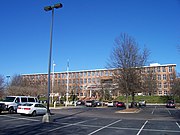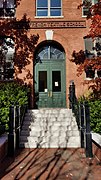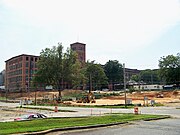User:JPRiley/Lockwood
| This is not a Wikipedia article: It is an individual user's work-in-progress page, and may be incomplete and/or unreliable. For guidance on developing this draft, see Wikipedia:So you made a userspace draft. Find sources: Google (books · news · scholar · free images · WP refs) · FENS · JSTOR · TWL |
History[edit]
Lockwood, Greene & Company[edit]
The firm that would become Lockwood, Greene & Company was established in 1871 in Boston as the mechanical engineering practice of Amos D. Lockwood. Lockwood, a native of Rhode Island, was self-trained in mechanical engineering and had extensive experience managing textile manufacturing and construction operations. Extenuating circumstances obligated him to move his residence to Providence in 1873 to manage his manufacturing interests.[1]
His office remained in Boston until 1875, when he relocated it to Providence, where he established A. D. Lockwood & Company to manage all of his business interests. His partner was John W. Danielson, his son-in-law, who had at least fifteen years of similar experience. In 1879 Lockwood hired the engineer Stephen Greene,[a] formerly associated with civil engineers Niles B. Schubarth and David M. Thompson. March 1, 1882, a new partnership was organized between Lockwood, Danielson and Greene, known as Lockwood, Greene & Company. Lockwood died January 16, 1884 in Providence. In 1886 Greene moved to Newburyport to be closer to the firm's business interests. In 1889 Danielson retired, selling his interest to Greene. The following January Greene moved the office to Boston, where it would remain. Lockwood, Greene & Company was incorporated January 1, 1901 in Massachusetts. Stephen Greene was the first president, and Frank E. Shedd the first vice president. Stephen Greene died unexpectedly November 7, 1901 at his home in Newton Center, where he had lived since relocating in 1890.[b] His eldest son, Edwin Farnham Greene, was elected president in Janaury, 1902.[c]
In 1892 George W. Stevens, former engineer for the Amoskeag Manufacturing Company of Manchester, New Hampshire, was hired as general superintendent of construction for southern work.[3] When Stevens died in 1897,[d] Joseph Emory Sirrene of Greenville, South Carolina was hired as his replacement the following year. In 1899, when a southern office was established, it was established at Greenville under Sirrene's direction.[1]
The first twenty years of Edwin F. Greene's presidency was a period of major growth of the company. Lockwood, Greene & Company had established its first branch office in 1899, at Greenville, South Carolina, to serve as the firm's southern office. This was followed by a third office in Chicago in 1911,[4] and in 1912 the southern office was relocated to Atlanta[1] and the Boston office was moved into the new First National Bank Annex at 60 State Street,[e] taking three full floors of the new building.[6] In 1913 offices were added in Montreal[7] and New York.[8] In 1919, after the close of World War I, offices were added at Cleveland, Detroit and Paris, the latter to manage reconstruction work. In 1920, offices were added at Charlotte and Philadelphia. In 1923, the southern headquarters was moved from Atlanta to Spartanburg, though the Atlanta office was retained.[1]
Lockwood, Greene & Company Inc.[edit]
In 1915, Greene organized a new Lockwood, Greene & Company Inc., with four subsidiary companies: Lockwood, Greene & Company, engineers, for design and construction; Lockwood, Greene & Company, managers, for management of manufacturing facilities owned or leased by the firm; Lockwood, Greene & Company of Canada Ltd. for foreign work; and the Greelock Company, a holding company for mill securities.[1]
In 1918 Frank W. Reynolds, an employee since 1885 and head of the drafting room since the 1890s, encouraged the establishment of an architectural department. To lead this, in early 1919 Walter W. Cook was hired.[f] This new department was in charge of exterior design in collaboration with the firm's other engineers.[1]
Lockwood Greene Engineers Inc.[edit]
In the 1920s, textile manufacturing revenues declined in New England and elsewhere, leaving the firm in a precarious financial condition. In early 1926, with the company under the control of a creditor's committee, the engineering and management subsidiaries were dissolved, their assets merged with those of the parent company. Edwin F. Green stepped down as president, and Albert L. Scott,[g] chairman of the former engineering subsidiary, suceeded him. Several branch offices were closed. These changes proved to be insufficient, and conditions worsened. By 1928, only the engineering department was generating a profit. As a result of these realities, in 1928 the firm was again reorganized. A new holding company, Building Engineers Inc., was formed by the directors, to which the engineering department sold. This new organization was then named Lockwood Greene Engineers Inc.[11] Within a month, Lockwood, Greene & Company gave up management of its remaining mills, effective October 1, 1928, leaving the old firm solely a holding company for mill securities.[12] Additionally, at this time the New York office was designated headquarters in place of Boston.[1]
In the reorganization the architectural department was merged with the engineers, and Walter W. Cook and his chief assistant George F. Blount left to establish their own firm, known as Cook & Blount, in New York.[1]
After the death of Scott in 1946 his replacement as president was Chester S. Allen.[13][h] In 1949 Allen was succeeded by Samuel B. Lincoln.[i][14] William J. Heiser was elected president in 1955,[j][15] J. Robert Potter in 1961,[k][16] and H. Morgan Rogers Jr. in 1968.[17] In the decades after World War II, the company once again grew rapidly.[1]
Later years[edit]
In 1973, Morgan moved the headquarters to Spartanburg from New York.[18] In 1981 Lockwood Greene was acquired by Philipp Holzmann AG, a German contractor. In 1982, Donald R. Luger was elected president to succeed Morgan.[19] In January of 1999 Holzmann merged Lockwood Greene with J.A. Jones Construction of Charlotte, North Carolina, a property of Holzmann since 1979.[20] The last president of the company was Fred M. Brune, named to that office in June of the same year.[21] Holzmann declared insolvency not long after, and was liquidated in 2002. Facing its own problems, Jones declared bankruptcy in 2003, after which Lockwood Greene was sold to CH2M Hill.[22] In 2007 the firm was renamed CH2M Hill Engineers. It became CH2M Engineers in 2015, and was folded into Jacobs Engineering Group in 2017 along with the rest of CH2M.
Projects[edit]
- Knowles Loom Works, Worcester, Massachusetts (1889, demolished)[23]
- Dallas Mill, Huntsville, Alabama (1890-91, NRHP 1978, burned 1991)[24]
- Dunnell Manufacturing Company Mills, Pawtucket, Rhode Island (1890)[25]
- Fairmont Mills, Fairmont, South Carolina (1890, burned 1977)[26]
- Columbia Mills,[l] Columbia, South Carolina (1893-94)[27]
- Pelzer Manufacturing Company Mill No. 4 and Power House,[m] Pelzer, South Carolina (1894-95)[28]
- Athenaeum Press, Cambridge, Massachusetts (1895, NRHP 1982)[29]
- Indian Head Mills, Cordova, Alabama (1897, demolished)[3]
- Lancaster Mills Power Plant,[n] Clinton, Massachusetts (1898, demolished)[30]
- French Building, Georgia Institute of Technology, Atlanta, Georgia (1898-99)[31]
- Loray Mills, Gastonia, North Carolina (1900-02, NRHP 2001)[32]
- Falmouth Hall, Kitson Hall and Southwick Hall, Lowell Technological Institute, Lowell, Massachusetts (1901-02)[33]
- Bolling Jones Building,[o] Atlanta, Georgia (1925, demolished 2019)[34]
- Central Building, Worcester, Massachusetts (1925)[35]
- Boardwalk Hall, Atlantic City, New Jersey (1926-29, 1964, NRHP 1987)[36]
- First National Bank Building,[p] Charlotte, North Carolina (1926-27)[37]
- Coxe Cage, Yale University, New Haven, Connecticut (1927-28)[38]
- Hunt Hall, Bucknell University, Lewisburg, Pennsylvania (1927)[39]
- Poplar Apartments, Charlotte, North Carolina (1929-30)[37]
- Union Leader Building,[q] Manchester, New Hampshire (1931-32)[40]
- Courier-Journal and Louisville Times Building,[r] Louisville, Kentucky (1946-48)[41]
- New England Confectionery Company Factory, Cambridge, Massachusetts (1927, NRHP 2005)[42]
Stopped at 1895
Gallery of projects[edit]
-
Dallas Mill, Huntsville, Alabama, 1890-91.
-
Columbia Mills, Columbia, South Carolina, 1893-94.
-
French Building, Georgia Institute of Technology, Atlanta, Georgia, 1898-99.
-
Loray Mills, Gastonia, North Carolina, 1900-02.
-
Southwick Hall, Lowell Technological Institute, Lowell, Massachusetts, 1901-02.
-
Bolling Jones Building, Atlanta, Georgia, 1925.
-
Boardwalk Hall, Atlantic City, New Jersey, 1926-29.
-
Courier-Journal and Louisville Times Building, Louisville, Kentucky, 1946-48.
Notes[edit]
- ^ Stephen Greene was born September 27, 1851 in Hope, Rhode Island to Alvin and Maria (Arnold) Greene. His father was a mill operative and superintendent. He was raised in mill villages in Rhode Island and Maine, and educated at home and in the district schools. Greene and his brothers also worked part time in the mills. After leaving the Westerly High School he entered Brown University in 1870 to study civil engineering. After leaving Brown in 1873 he joined the office of civil engineer and architect Niles B. Schubarth as junior partner. In 1874 he married Schubarth's daughter. In 1875 he moved to the office of mill engineer David M. Thompson, and was superindendent of construction for the new Elizabeth Mill at Hillsgrove in 1876. After his first son was born he returned to Providence to work for Lockwood.[2]
- ^ Greene's family home, built in 1892, still stands at 1038 Centre Street.[2]
- ^ Edwin Farnham Greene was born February 9, 1879 in Hillsgrove, Rhode Island. He graduated from Worcester Academy in 1897 and Brown University in 1901. He died December 7, 1956 in New York.
- ^ Stevens died in Cordova, Alabama, where he was superintending the construction of the Indian Head Mills.[3]
- ^ Designed by R. Clipston Sturgis.[5]
- ^ Walter W. Cook was formerly an employee of twelve years of Shepley, Rutan & Coolidge and project manager for the United States Housing Corporation.[1] He died in 1968 in Dallas.[9]
- ^ Albert Lyon Scott was born June 21, 1879 in Cleveland, Ohio and died March 2, 1946 in Chappaqua, New York.[10]
- ^ Chester Salisbury Allen was born November 25, 1881 in Massachusetts. He joined Lockwood, Greene & Company as an engineer in 1910. He died January 6, 1952 in Auburndale, Massachusetts.
- ^ Samuel Bicknell Lincoln was born May 14, 1882 in Blackstone, Massachusetts. He joined Lockwood, Greene & Company in 1906. He died February 19, 1984 in West Harwich, Massachusetts.
- ^ William J. Heiser was born x in x. He died in 1976 in Garden City, New York.
- ^ John Robert Potter was born September 29, 1908 and died September 21, 1968.
- ^ When completed, this was the first textile mill in the world to be fully powered by electricity.
- ^ The power house at the Lower Pelzer Mills Dam, three miles below the mill, made Pelzer No. 4 the first textile mill in the world to be powered via electric transmission lines.
- ^ The addition of this power plant made the Lancaster Mills the first large manufacturer to be supplied by electric power in New England.
- ^ Built as a large parking garage, later Kell Hall of Georgia State University.
- ^ Designed in association with architect Louis H. Asbury of Charlotte.
- ^ Presently the Manchester Courthouse.
- ^ Designed in association with Joseph H. Kolbrook of Louisville.
References[edit]
- ^ a b c d e f g h i j Samuel B. Lincoln, Lockwood Greene: The History of an Engineering Business, 1832-1958 (Brattleboro: Stephen Greene Press, 1960)
- ^ a b Benjamin A. Greene, Stephen Greene: Memories of His Life (Evanston: Benjamin A. Greene, 2003)
- ^ a b c "Obituary," Engineering News 38, no. 15 (October 7 1897): 127.
- ^ "Opens a Chicago Office," National Corporation Reporter 43, no. 11 (October 26 1911): 363.
- ^ "BOS.1718". mhc-macris.net. Massachusetts Historical Commission, n. d. Accessed June 7 2021.
- ^ "Real Estate Transactions," Boston Daily Globe, October 24 1912, 17.
- ^ "Trade Notes," Steel 53, no. 12 (September 18 1913): 532.
- ^ "Mill Notes," American Wool and Cotton Reporter 27, no. 8 (February 20 1913): 265.
- ^ "Obituaries," Engineering News-Record 181, no. 4 (September 19 1968): 197.
- ^ "Albert L. Scott," Architectural Record 99, no. 5 (May 1946): 10.
- ^ "Heard on the Street," Boston Globe, August 4 1928, 10.
- ^ "Heard on the Street," Boston Globe, September 16 1928, a59.
- ^ "Record Reports," Architectural Record 99, no. 6 (June 1946): 142.
- ^ "Notices," Progressive Architecture 30, no. 6 (June 1949): 16.
- ^ Engineering News-Record 154, no. 8 (February 4 1955)
- ^ "Notices," Progressive Architecture 42, no. 7 (July 1961): 200.
- ^ Engineering News-Record 181, no. 19 (November 7 1968)
- ^ Judith T. Bainbridge, "Lockwood Greene," The South Carolina Encyclopedia (Columbia: University of South Carolina Press, 2006), also at South Carolina Encyclopedia.
- ^ Tappi 65, no. 5 (May 1982): 213
- ^ Carolyn Farr Smith, "Lockwood Greene, J.A. Jones to merge," goupstate.com, Spartanburg Herald-Journal, January 19 1999, accessed June 12 2021.
- ^ Carolyn Farr Smith, "Consulting firm president has grand designs for the future A new leader at Lockwood Greene," goupstate.com, Spartanburg Herald-Journal, July 24 1999, accessed June 12 2021.
- ^ "CH2M Hill Wins Prize In Bankruptcy Contest Lockwood Greene is sold by bankrupt J.A. Jones for $95.5 million as bid trumps two competitors," enr.com, Engineering News-Record, December 22 2003, accessed June 12 2021.
- ^ "Knowles Loom Works," Wade's Fibre and Fabric 9, no. 226 (June 29 1889): 142.
- ^ "Southern Engineering Notes," Engineering and Mining Journal 1, no. 23 (December 6 1890): 656.
- ^ Five Hundred Representative Buildings Heated and Ventilated by the Sturtevant System (Boston: B. F. Sturtevant Company, 1890)
- ^ "Engineering and Manufacturing Notes," American Engineer 19, no. 24 (June 11 1890): 261.
- ^ Columbia Mills Building NRHP Registration Form (1982)
- ^ "The Power Plant at Pelzer, S. C.," Engineering Record 33, no. 22 (May 2 1896): 386-388.
- ^ "Building Intelligence," American Architect and Building News 48, no. 1007 (April 13 1895): xvi.
- ^ "New Power Plant for the Lancaster Mills," Engineering Record 40, no. 14 (September 2 1899): 315-318.
- ^ https://exhibit-archive.library.gatech.edu/gtbuildings/hall.htm
- ^ Loray Mill Historic District NRHP Registration Form (2001)
- ^ "Lowell Textile School's New Home," Boston Daily Globe, May 23 1901, 6.
- ^ http://sites.gsu.edu/historyofourstreets/2015/11/10/kell-hall-2/
- ^ Advertisement for Duraflex Company in Architectural Flooring 43, no. 6 (December 1925): 122.
- ^ Atlantic City Convention Hall NRHP Registration Form (1987)
- ^ a b https://ncarchitects.lib.ncsu.edu/people/P000300
- ^ Patrick L. Pinnell, Yale University: An Architectural Tour (New York: Princeton Architectural Press, 1999)
- ^ http://www.departments.bucknell.edu/edu/bu_history_old/photo_history/1945/1945_Hunt.html
- ^ "Real Estate Transactions," Boston Globe, February 1 1931, a28.
- ^ "Newspaper Plant," Architectural Record 99, no. 2 (February 1946): 14 and 16.
- ^ "CAM.1366." mhc-macris.net. Massachusetts Historical Commission, n. d. Accessed December 10 2021.
- Fourscore Years: A Record of Lockwood, Greene & Co.'s Contribution to Industrial Engineering (Boston: Lockwood, Greene & Company, 1912)
- "Stephen Greene" in Lamb's Textile Industry of the United States, vol. 1, ed. John Howard Brown and E. N. Morris (Boston: James H. Lamb Company, 1911): 339-340.











